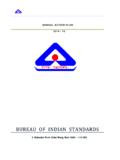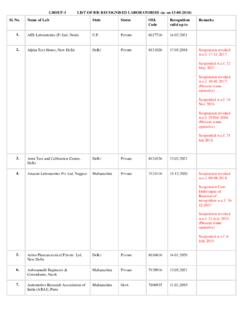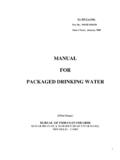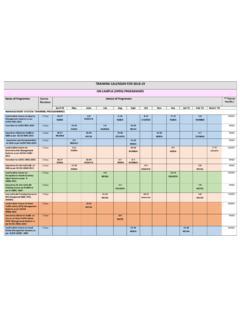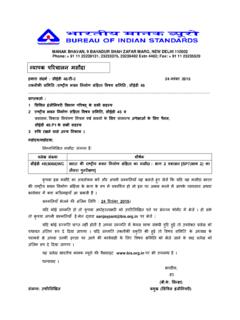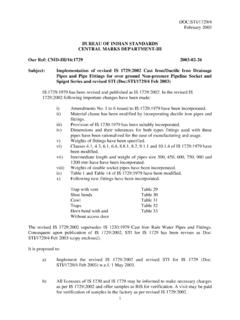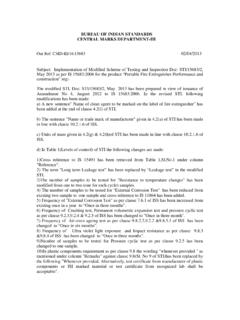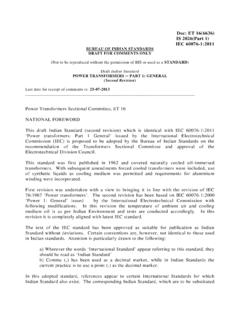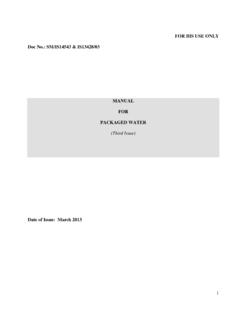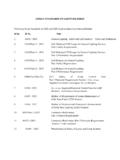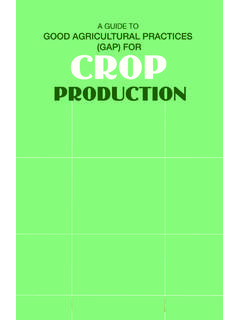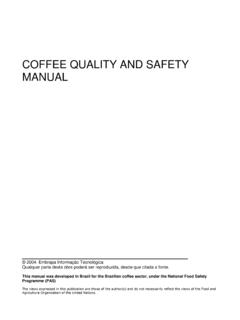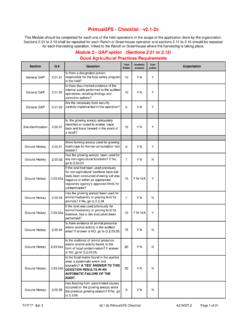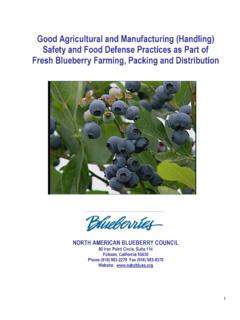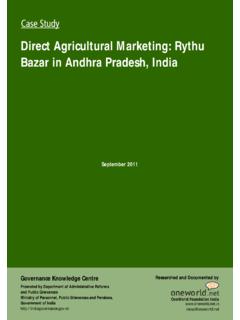Transcription of Draft Indian Standard REQUIREMENTS FOR GOOD …
1 Doc: FAD 22(1949)C. Draft for Comments Only Last Date for Comments Not to be reproduced without 31st October 2008. Permission of BIS or used as Standard . Draft Indian Standard REQUIREMENTS FOR. good agricultural practices . IndiaGAP. PART 1 CROP BASE. ICS No. BUREAU OF Indian STANDARDS. MANAK BHAWAN, 9, BAHADUR SHAH ZAFAR MARG. NEW DELHI 110002. Date Price group Doc: FAD 22(1949)C. Draft for Comments Only Last Date for Comments Not to be reproduced without 31st October 2008. Permission of BIS or used as Standard . Draft Indian Standard REQUIREMENTS FOR. good agricultural practices . IndiaGAP. PART 1 CROP BASE. FOREWORD. (Formal clause would be added later).
2 Considerable milestones have been reached in productivity of farm produce in the country. Concerns about food safety and quality, environmental protection, worker safety and welfare have also gained importance. Thus, it is desirable to set up control and compliance systems for various kinds of farm produce covering horticulture, floriculture, food grains, aquaculture, livestock etc. In this context, it is necessary to pay attention to the quality of production practices requiring minute attention at different aspects of production, handling and distribution. There are different systems and standards available for control measures in value addition through processing of food meant for human consumption and animals producing food for human consumption.
3 The areas where appropriate control measures need to be strengthened are farms producing raw material such as food grains, fruits and vegetables, floriculture, aquaculture, livestock etc. to ensure sustained supply of produce of the desirable quality. Although grade standards on size, shape, colour and local preferences are available for most of the agricultural produce marketed and consumed in India, their quality in terms of maturity standards, residues of pesticides and other contaminants, microbial loads, etc. have not been adequately covered. good agricultural practices (GAP) have a bearing on these parameters. In other words, a farm producing raw material for direct consumption or for further processing and following GAP would have an advantage in terms of safety and quality over the other farms.
4 Thus, these practices would add value to the produce. In India, agricultural practices are highly localized occupations and display a lot of variability in cultural practices and varietal preferences across regions. Further, with the opening up of the world market, there is a flow of trade in the agricultural products. It is, therefore, necessary to define and assign certain common minimum standards to facilitate trade in these products and to win the confidence of the consumers within the country and outside. Doc: FAD 22(1949)C. Such standards envisaging focused approach for implementing good agricultural practices , traceability etc. through appropriate infrastructure, record keeping and monitoring would reap following broad benefits: development of basic infrastructure at the field level, build up culture for good agricultural practices by the farmers, uniform approach across farms regardless of their sizes increased awareness among the farmers as well as the consumers about the need for consumption of good quality and safe food, traceability through complete integration of food chain, improvement in the environment as well as soil fertility worker safety and welfare.
5 Reputation in the international market as a producer of good quality and safe produce, and removal of Technical Barriers to Trade (TBTs) faced by exporters of agro products. With this in view this Draft Indian Standard (Part 1) has been formulated to standardize Crop Based agricultural practices in India keeping in mind the best of international practices and suiting the needs of the Indian farmer. Keeping global trade of agricultural produce in perspective the Control Points in this Draft Indian Standard have been aligned with GlobalGAP but the Compliance Criteria are based on Indian practices . It has been designed in a manner that facilitates benchmarking with similar documents at international level if the need arises to give it an international dimension.
6 This Draft Indian Standard (Part 1) is first in a series of Indian Standards on good agricultural practices to be developed. The other parts would cover Livestock Based and Aquaculture Based good agricultural practices . The Draft Indian Standard good agricultural practices IndiaGAP Part 1 Crop Base takes into account not only the quality and quantity of the crop obtained from an unit area but also the care and attention gone into integrating preharvest practices like soil & water management, nutrient management and pest management, harvesting, post harvest handling and other logistics. The objective is to ensure food safety, occupational health/safety/welfare, and wherever possible animal welfare.
7 The entire operation is intended to make farming practices environment friendly. Implementation of IndiaGAP is voluntary and non-discriminatory to the growers or certification bodies. In the formulation of this Draft Indian Standard (part 1) considerable assistance has been derived from the Draft document prepared by agricultural and Processed Food Products Export Development Authority (APEDA). For the purposes of preparing this document, relevant ISO guides were taken into consideration. Doc: FAD 22(1949)C. 1. SCOPE. This Draft Indian Standard (Part 1) covers the control points and compliance criteria necessary to be followed by the producers (individual growers and/or members of a grower group) of crops.
8 The Draft Indian Standard (Part 1) covers the following products in fresh form for direct human consumption or after further processing or for feed for animals producing food for human consumption: a) Fruits and vegetables b) Food grains c) Plantation crops d) Spices and condiments e) Oilseeds and nuts. 2 TERMINOLOGY. good Agriculture practices : practices that address environmental, economic and social sustainability for on-farm processes, and result in safe and quality food and non-food agricultural products. Applicant grower/grower group: Individual/organization that has applied for certification to IndiaGAP certification body. Pesticide: Plant protection and growth regulating product.
9 Certification Body: Bureau of Indian Standards, established under Bureau of Indian Standards Act, 1986. Hazard: A biological, chemical, physical agent in, or condition of, food with the potential to cause an adverse health effect. Individual grower: A person/organization legally responsible for on farm production, who retains ownership of all the produce covered in the IndiaGAP. licence. Inspection: An examination of all agricultural practices in order to verify compliance to REQUIREMENTS specified in this Standard . Water, Irrigation: Water which is artificially applied in the process of irrigation. It does not include precipitation. Water, Potable: Water which does not contain objectionable pollution, contamination, minerals, or infection, and is considered satisfactory for domestic consumption.
10 Produce : The harvested product of the crop before it is sold. Product: The produce sold to the customers. Record: Document showing objective evidence of the tasks performed and results achieved. Self-Inspection: Internal inspection of the registered product crop carried out by the grower on his/her farm using Control Points and Compliance Criteria. Trace-back: The ability to trace the history, use or location of a product ( , the origin of materials and parts, processes applied to the product, or its distribution and placement after delivery) by means of a record. Worker: Any person on the farm that has been contracted to carry out a task. This includes farm owners and managers.
